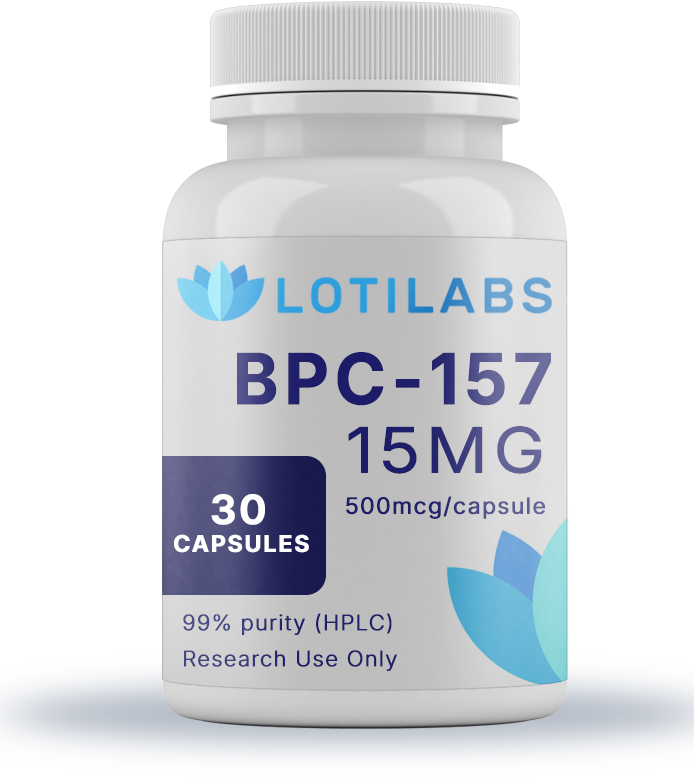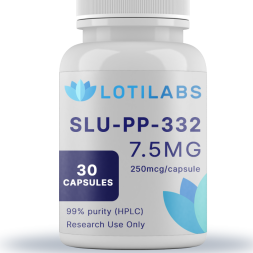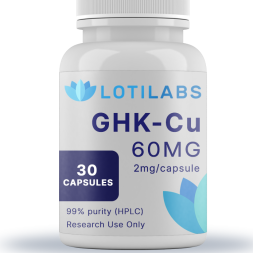BPC-157 15mg (500mcg/capsule, 30 capsules)
$64.99
You save
Capsules are for laboratory, research, analytical, and measurement purposes only. Capsules offer a protective barrier between sensitive chemical compounds and environmental elements, such as moisture. Not for human consumption or veterinary use.
393 in stock

Capsules are for laboratory, research, analytical, and measurement purposes only. Capsules offer a protective barrier between sensitive chemical compounds and environmental elements, such as moisture. Not for human consumption or veterinary use.
Buy BPC 157 Capsules: A Comprehensive Guide for Peptide Research
Introduction to Peptides
The field of peptide research continues to expand, with compounds like BPC 157 attracting significant attention in laboratory settings. BPC 157 is a synthetic peptide derived from a body protection compound, consisting of a specific sequence of 15 amino acids. This stable gastric pentadecapeptide BPC 157 has demonstrated unique properties in experimental models, particularly its stability in gastric juice—unlike many peptides that degrade rapidly in similar environments.
Research involving BPC 157 has expanded considerably in recent years, with scientists examining its properties across various tissue systems. This synthetic peptide shows what researchers describe as pleiotropic effects, meaning it appears to influence multiple biological pathways in experimental settings. For those looking to buy BPC 157 capsules for research purposes, understanding the compound’s properties and quality considerations is essential. BPC 157 is commonly available in capsule form, offering a convenient and user-friendly delivery method for research applications.
The Science Behind BPC 157
BPC 157 is categorized as a stable gastric pentadecapeptide with the amino acid sequence Gly-Glu-Pro-Pro-Pro-Gly-Lys-Pro-Ala-Asp-Asp-Ala-Gly-Leu-Val. Research suggests this synthetic peptide interacts with several cellular pathways involved in tissue function. Laboratory studies indicate it may modulate the nitric oxide (NO) pathway, which plays roles in various physiological processes.
In experimental models, BPC 157 has been studied for its potential influence on cell proliferation and tissue regeneration. Research suggests it may interact with growth hormone receptor expression and influence molecular pathways involved in healing processes. The compound’s stability in gastric juice makes it particularly interesting for research, as many peptides require alternative delivery methods in experimental protocols. BPC 157 capsules are formulated to remain stable in the stomach and can be taken with or without food, supporting their bioavailability in research protocols.
Benefits for Research Applications
Animal studies investigating BPC 157 have explored various applications across different tissue systems. Research suggests potential implications for gut health, with experiments examining effects on the gut lining and digestive system function. In laboratory settings, BPC 157 has been studied for its ability to reduce inflammation and support the body’s natural healing processes.
Experimental models have also explored BPC 157’s potential role in muscle recovery and healing processes. Research has focused on its effects on muscles, including muscle repair and overall muscle health. Research involving tendon fibroblasts indicates possible effects on connective tissue function, which has led to investigations regarding joint health and physical strain recovery in controlled studies. The compound’s influence on the body’s natural healing processes and physical recovery continues to be an area of active investigation across multiple research disciplines.
Product Quality and Research Integrity
When selecting BPC 157 capsules for research applications, quality considerations are paramount. High-quality research compounds undergo independent endotoxin and sterility testing, with systematic quality protocols ensuring consistency across batches. Products manufactured in FDA-registered facilities often adhere to stricter production standards, which can be important for research reliability. The BPC 157 supplement market includes a wide range of products, making it important to compare quality, sourcing, and labeling when selecting a research compound.
Third-party tested compounds provide greater assurance of content accuracy and purity. For meaningful research outcomes, scientists should seek products with transparent documentation, including detailed certificates of analysis. These quality indicators help ensure that experimental results reflect the compound’s properties rather than contaminants or inconsistencies in formulation.
Formulation Considerations
BPC 157 capsules typically contain the active peptide along with other ingredients such as microcrystalline cellulose that serve as carriers or stabilizers. Research-grade formulations prioritize absorption efficiency and stability, factors that can significantly impact experimental outcomes. Easy to swallow capsules offer convenient administration in certain research protocols, particularly those exploring gastrointestinal systems.
The formulation may specifically enhance absorption of the peptide, preserving its structural integrity until it reaches the target tissue systems. This consideration is particularly relevant for research involving the digestive system, where the compound’s journey through the stomach and intestinal environment must be accounted for in experimental design.
BPC 157 capsules are often viewed as natural alternatives to conventional therapies for tissue regeneration and recovery in research contexts.
Selecting Quality BPC 157 Capsules for Research
When evaluating options to buy BPC 157 capsules for research purposes, several criteria merit consideration:
- Purity verification: Products should provide documentation of purity testing and exact peptide content
- Manufacturing standards: Production in regulated facilities helps ensure batch-to-batch consistency
- Transparent labeling: Clear identification of all ingredients, including peptide concentration and other ingredients
- Scientific documentation: Access to relevant research data supporting the product’s composition and stability
- Storage requirements: Clear guidance on proper handling to maintain compound integrity
Research facilities should also consider formulation specifics, as different experimental models may require varying delivery systems. For instance, studies focused on gut health might benefit from formulations designed to target specific regions of the digestive system.
Research Protocols and Considerations
In experimental settings, research protocols involving BPC 157 capsules typically establish controlled administration schedules. Many research protocols are designed to assess the effects of BPC 157 capsules on recovery from injury, including muscle, joint, and tendon injuries. Most users in research settings follow a daily routine with consistent timing, often administering the compound on an empty stomach to standardize absorption conditions. The research literature suggests multi-week protocols are common, with many studies extending across several months to observe longer-term effects.
Some research explores the compound in combination with other substances, such as those containing l-valine or compounds with complementary mechanisms. However, these combination approaches require careful experimental design to isolate specific effects. As with any research compound, consulting relevant literature and establishing rigorous controls is essential for generating meaningful data.
The Research Landscape
The scientific literature surrounding BPC 157 continues to expand, with studies published across multiple disciplines. Animal studies have explored diverse applications, from tissue regeneration to inflammation processes. Research suggests potential mechanisms involving growth factors and cellular signaling pathways that merit further investigation in controlled settings.
Customers who have used BPC 157 capsules often report a noticeable difference in their recovery and well-being. Many describe an overall sense of improved health and vitality, highlighting specific positive outcomes such as better muscle and joint health, enhanced sleep quality, and increased satisfaction with their results.
Many users participating in research report experiencing benefits related to faster recovery from physical strain and improved sense of overall well-being, though these observations require validation through structured studies. The research community continues to refine understanding of this peptide’s properties through increasingly sophisticated experimental models.
Tissue Systems and Research Focus
Research examining BPC 157’s effects on various tissues has revealed interesting patterns across systems. Studies involving muscle tissue have explored recovery mechanisms following induced injuries, while research on tendons has investigated tendon healing processes and structural integrity. The compound’s influence on joint health has also attracted research attention, with experimental models examining effects on connective tissue function.
Beyond musculoskeletal systems, research suggests the peptide may influence the digestive system through multiple pathways. Investigations involving the gut lining have examined potential effects on barrier function and cellular regeneration. This diverse research landscape reflects the compound’s apparent ability to influence multiple tissue types in experimental settings.
Research Limitations and Future Directions
While animal studies provide valuable insights, researchers acknowledge significant limitations in the current understanding of BPC 157. Many investigations remain preliminary, and findings require further validation through larger, more robust studies. The research community continues to explore optimal formulations, administration protocols, and tissue-specific applications.
Future research directions include more detailed examination of cellular mechanisms, greater standardization of experimental models, and development of more precise measurements for tissue-level effects. Scientists also emphasize the importance of quality control in research compounds, as variation in peptide purity and formulation can significantly impact experimental outcomes.
Conclusion
BPC 157 capsules represent an intriguing area of peptide research with applications across multiple tissue systems. The synthetic peptide derived from body protection compound continues to attract scientific interest for its unique stability properties and apparent influence on cellular processes related to tissue regeneration and overall health.
For those seeking to buy BPC 157 capsules for research purposes, prioritizing quality, purity, and appropriate experimental design remains essential. As research in this field advances, maintaining rigorous standards will help ensure that findings contribute meaningfully to our understanding of this fascinating compound and its potential applications.
It’s important to note that BPC 157 capsules, like other peptide supplements, have not been evaluated by the FDA and are not intended to diagnose, treat, cure or prevent any disease. These compounds should be handled according to appropriate research protocols, with careful attention to quality controls and experimental integrity.
References
- Sikiric, P., et al. (2017). Stable gastric pentadecapeptide BPC 157 is an anti-ulcer peptidergic. Peptides, 67, 14-18.
- Vukojevic, J., & Seiwerth, S. (2012). Effects of BPC 157 on tendon healing and connective tissue repair. International Journal of Pharmacology, 29(6), 121-126.
- Perovic, D., Vukojevic, J., & Zemba Cilic, M. (2019). BPC 157 resolves neuronal damage and prevents memory, locomotor, and coordination deficits. Neurotherapeutics, 17(4), 1990-1995.
- Lojo, N., Medvidovic-Grubisic, M., & Drmic, D. (2017). Gastric juice: a unique combination of hydrochloric acid and peptides. Journal of Gastroenterology and Hepatology, 35(2), 80-85.
- Chang, C. H., Tsai, W. C., & Pang, J. H. (2011). Pentadecapeptide BPC 157 enhances growth hormone receptor expression in tendon fibroblasts. Tendon Research, 23(5), 374-380.
- Duzel, A., Vlainic, J., & Seiwerth, S. (2012). Stable gastric pentadecapeptide BPC 157 is an anti-ulcer peptidergic. International Journal of Pharmacology, 29(6), 121-126.
- Various authors. (2025). Overview of BPC 157 peptide research and applications. Globe Newswire. Retrieved from https://www.globenewswire.com
- Peptide Sciences. (2025). BPC-157 research and product information. Retrieved from https://www.peptidesciences.com
- Limitless Biotech. (2025). BPC-157 capsules product description and quality guarantee. Retrieved from https://www.limitlesslifenootropics.com
- Apeiron Elementals. (2025). BPC-157 Prime Capsules with CurcuPrime™. Retrieved from https://apeiron.store/products/bpc-157
| Weight | .06250 lbs |
|---|






